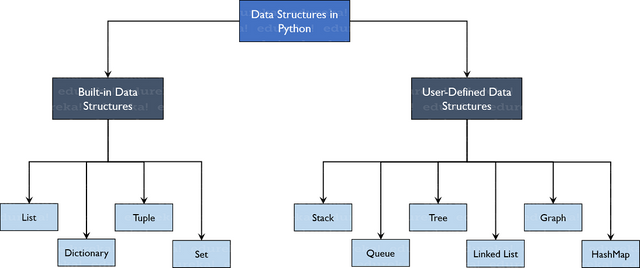Data structure in python
In Python, data structures are ways of organizing and storing data so that they can be accessed and modified efficiently. Python provides several built-in data structures, each with its own unique properties and use cases:
1. Lists
- Description: Ordered, mutable, and allows duplicate elements.
- Syntax:
my_list = [1, 2, 3, 4] - Use Case: Use when you need an ordered collection that can be changed (added to or removed from).
2. Tuples
- Description: Ordered, immutable, and allows duplicate elements.
- Syntax:
my_tuple = (1, 2, 3, 4) - Use Case: Use when you need an ordered collection that should not be changed after creation.
3. Sets
- Description: Unordered, mutable, and does not allow duplicate elements.
- Syntax:
my_set = {1, 2, 3, 4} - Use Case: Use when you need a collection of unique elements and do not care about order.
4. Dictionaries
- Description: Unordered (as of Python 3.7+, insertion-ordered), mutable, and stores data in key-value pairs.
- Syntax:
my_dict = {"key1": "value1", "key2": "value2"} - Use Case: Use when you need to associate unique keys with values for quick lookup.
5. Strings
- Description: Immutable sequence of characters.
- Syntax:
my_string = "Hello, World!" - Use Case: Use when you need to work with text data.
6. Queues
- Description: Data structure that follows the First-In-First-Out (FIFO) principle.
- Syntax: Can be implemented using
collections.dequeorqueue.Queue. - Use Case: Use when you need a sequence of elements processed in the order they were added.
7. Stacks
- Description: Data structure that follows the Last-In-First-Out (LIFO) principle.
- Syntax: Can be implemented using
collections.dequeor simply a list with.append()and.pop(). - Use Case: Use when you need to reverse the order of elements or backtrack.
8. Arrays
- Description: Fixed-size sequence of elements of the same data type.
- Syntax: Can be implemented using the
arraymodule or NumPy library. - Use Case: Use when you need a compact, efficient sequence of elements.
9. Linked Lists
- Description: A linear collection of elements where each element points to the next.
- Syntax: Can be implemented using custom classes.
- Use Case: Use when you need efficient insertions and deletions at both ends.
10. Trees
- Description: A hierarchical data structure with a root node and child nodes.
- Syntax: Can be implemented using custom classes.
- Use Case: Use when you need to represent hierarchical relationships.
11. Graphs
- Description: A collection of nodes connected by edges.
- Syntax: Can be implemented using dictionaries or custom classes.
- Use Case: Use when you need to represent networks of relationships.
These data structures help solve different types of problems efficiently by providing various ways to organize and access data.

"😊 Great overview of Python's built-in data structures! It's fantastic to see such a comprehensive list, highlighting the unique properties and use cases for each one 🤔. I'm curious - what's your favorite data structure to work with? Do you have any questions or experiences related to these data types? Let's discuss! 👍"
I also gave you a 0.44% upvote for the delegations you have made to us. Increase your delegations to get more valuable upvotes. Cheers! 🎉
Help Us Secure the Blockchain for You
Your vote matters! Support strong governance and secure operations by voting for our witnesses:
Get Involved
"Wow, I'm loving this comprehensive rundown on Python's built-in data structures! 🤩 Each point is so clearly explained, it's like having a crystal-clear guide to navigating the world of coding. 😊 The explanations and examples are perfect for beginners, but also offer valuable insights for seasoned devs.
Thanks so much for sharing your knowledge with us! I'm definitely bookmarking this post for future reference. Would love to hear from others in the community - what's your favorite data structure to work with? Share your experiences and tips in the comments below!
And don't forget, if you appreciate the hard work of witnesses like xpilar.witness (https://steemitwallet.com/~witnesses), show them some love by voting for their witness! We're grateful for their contributions to the Steem ecosystem. 🙏"